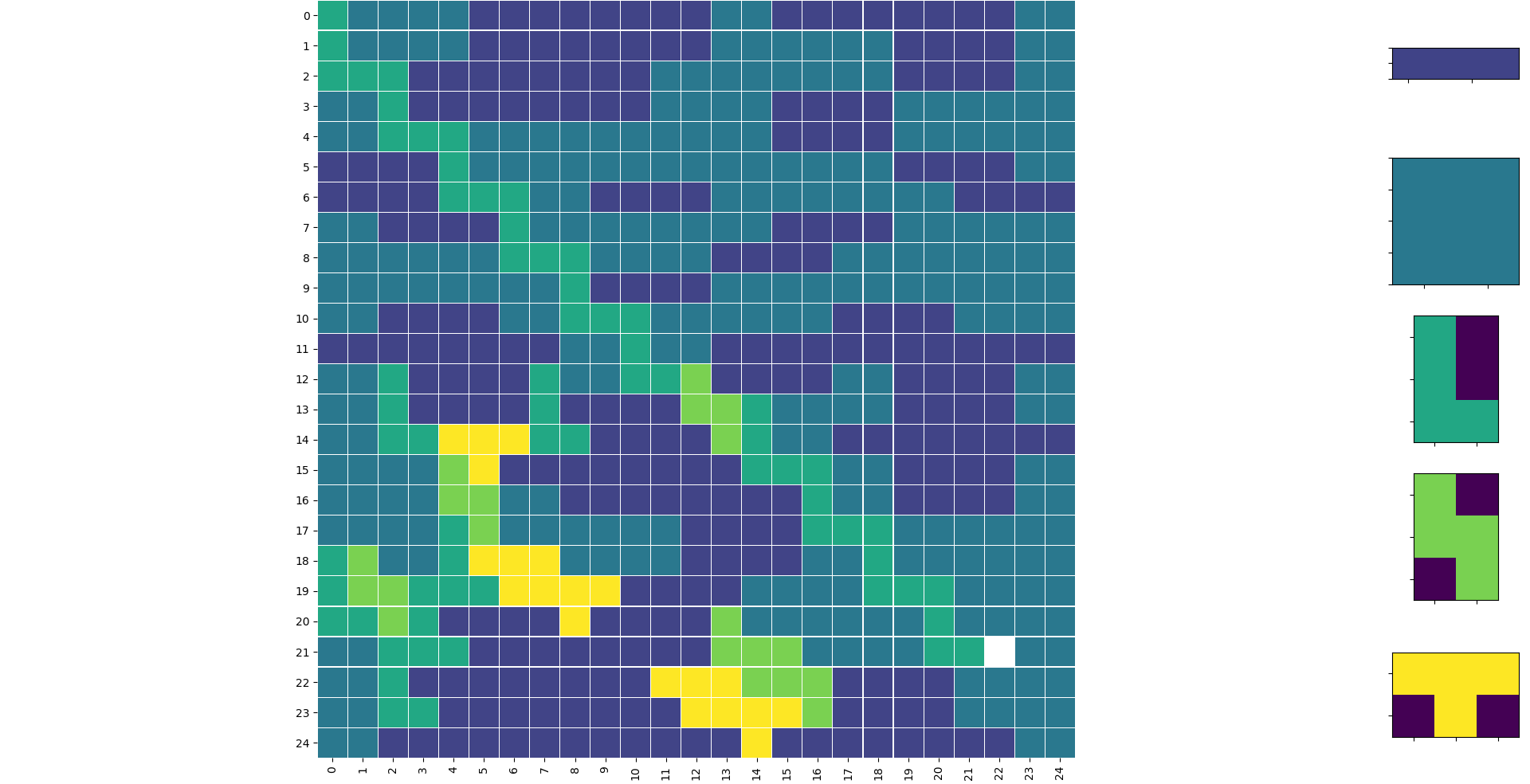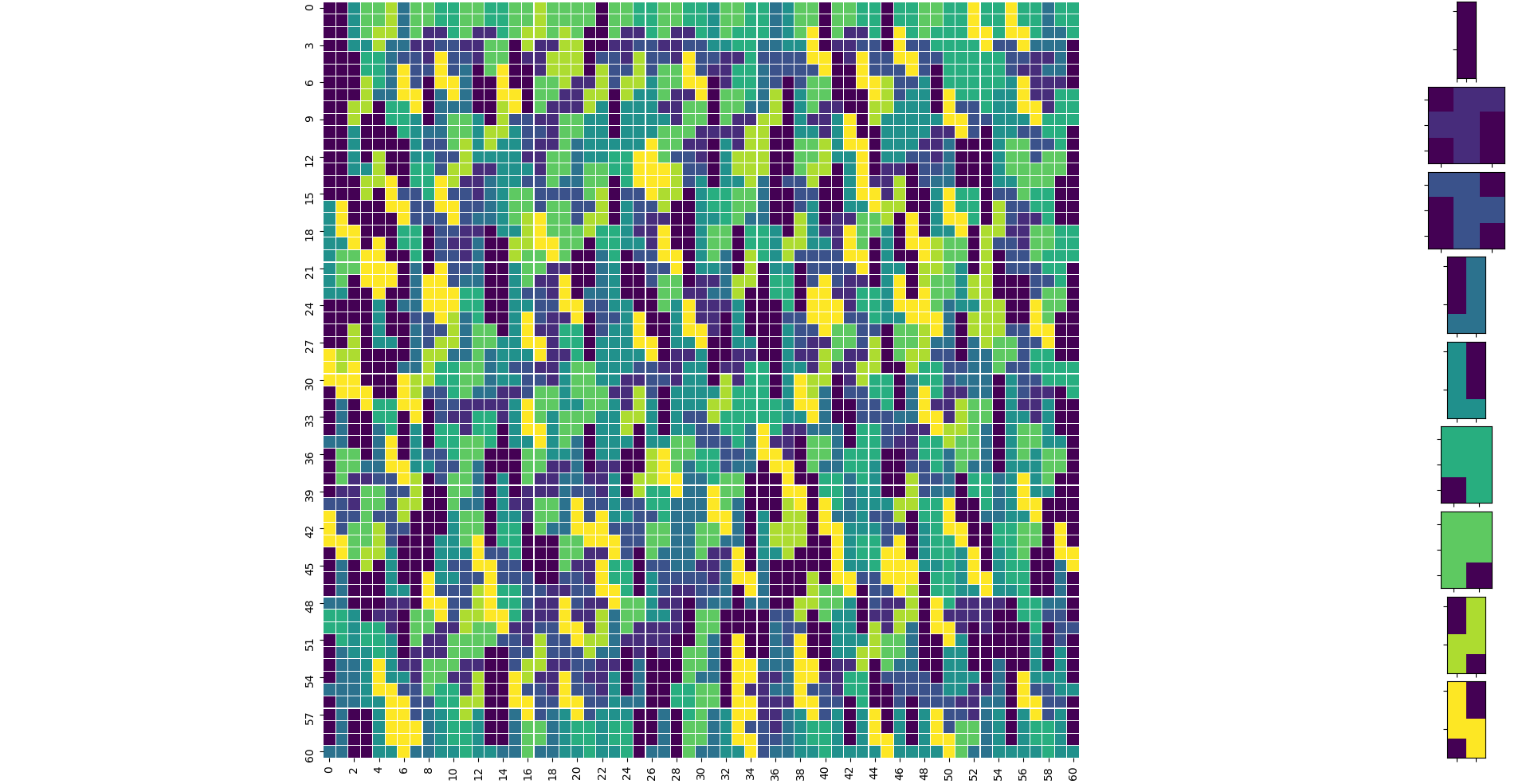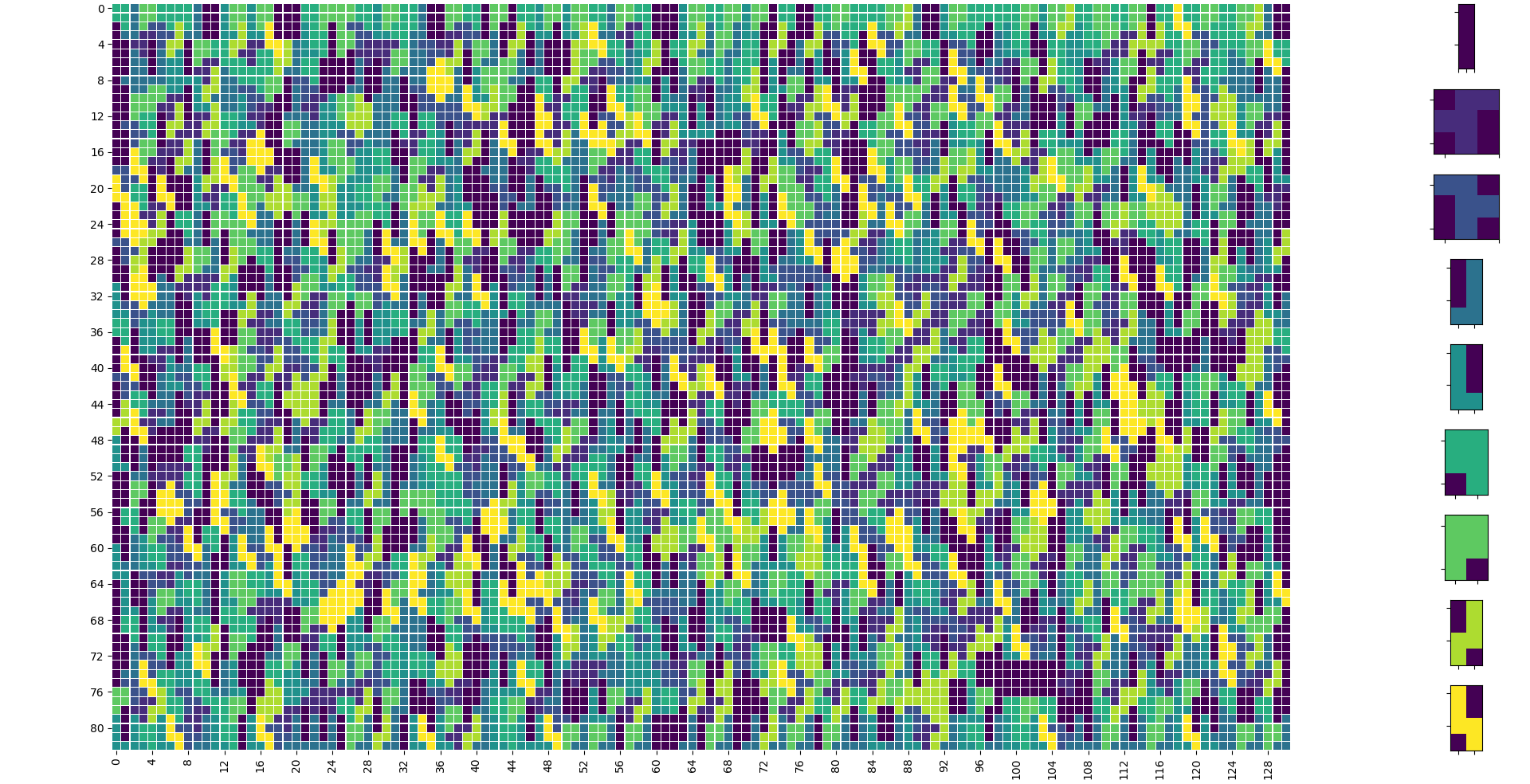Here is a prototype-like SAT-solver approach, which tackles:
- a-priori fixed polyomino patterns (see
Constants / Input in code)
- if rotations should be allowed, rotated pieces have to be added to the set
- every polyomino can be placed 0-inf times
- there is no scoring-mechanic besides:
- the number of non-covered tiles is minimized!
Considering classic off-the-shelf methods for combinatorial-optimization (SAT, CP, MIP), this one will probably scale best (educated guess). It will also be very hard to beat when designing customized heuristics!
If needed, these slides provide some practical introduction to SAT-solvers in practice. Here we are using CDCL-based solvers which are complete (will always find a solution in finite time if there is one; will always be able to prove there is no solution in finite time if there is none; memory of course also plays a role!).
More complex (linear) per-tile scoring-functions are hard to incorporate in general. This is where a (M)IP-approach can be better. But in terms of pure search SAT-solving is much faster in general.
The N=25 problem with my polyomino-set takes ~ 1 second (and one could easily parallize this on multiple granularity-levels -> SAT-solver (threadings-param) vs. outer-loop; the latter will be explained later).
Of course the following holds:
- as this is an NP-hard problem, there will be easy and non-easy instances
- i did not do scientific benchmarks with many different sets of polyominos
- it's to be expected that some sets are easier to solve than others
- this is one possible SAT-formulation (not the most trivial!) of infinite many
- each formulation has advantages and disadvantages
Idea
The general approach is creating a decision-problem and transforming it into CNF, which is then solved by highly efficient SAT-solvers (here: cryptominisat; CNF will be in DIMCAS-CNF format), which will be used as black-box solvers (no parameter-tuning!).
As the goal is to optimize the number of filled tiles and we are using a decision-problem, we need an outer-loop, adding a minimum tile-used constraint and try to solve it. If not successful, decrease this number. So in general we are calling the SAT-solver multiple times (from scratch!).
There are many different formulations / transformations to CNF possible. Here we use (binary) decision-variables X which indicate a placement. A placement is a tuple like polyomino, x_index, y_index (this index marks the top-left field of some pattern). There is a one-to-one mapping between the number of variables and the number of possible placements of all polyominos.
The core idea is: search in the space of all possible placement-combinations for one solution, which is not invalidating some constraints.
Additionally, we have decision-variables Y, which indicate a tile being filled. There are M*N such variables.
When having access to all possible placements, it's easy to calculate a collision-set for each tile-index (M*N). Given some fixed tile, we can check which placements can fill this one and constrain the problem to only select <=1 of those. This is active on X. In the (M)IP world this probably would be called convex-hull for the collisions.
n<=k-constraints are ubiquitous in SAT-solving and many different formulations are possible. Naive-encoding would need an exponential number of clauses in general which easily becomes infeasibly. Using new variables, there are many variable-clause trade-offs (see Tseitin-encoding) possible. I'm reusing one (old code; only reason why my code is python2-only) which worked good for me in the past. It's based on describing hardware-based counter-logic into CNF and provides good empirical- and theoretical performance (see paper). Of course there are many alternatives.
Additionally, we need to force the SAT-solver not to make all variables negative. We have to add constraints describing the following (that's one approach):
- if some field is used: there has to be at least one placement active (poly + x + y), which results in covering this field!
- this is a basic logical implication easily formulated as one potentially big logical or
Then only the core-loop is missing, trying to fill N fields, then N-1 until successful. This is again using the n<=k formulation mentioned earlier.
Code
This is python2-code, which needs the SAT-solver cryptominisat 5 in the directory the script is run from.
I'm also using tools from python's excellent scientific-stack.
# PYTHON 2!
import math
import copy
import subprocess
import numpy as np
import matplotlib.pyplot as plt # plotting-only
import seaborn as sns # plotting-only
np.set_printoptions(linewidth=120) # more nice console-output
""" Constants / Input
Example: 5 tetrominoes; no rotation """
M, N = 25, 25
polyominos = [np.array([[1,1,1,1]]),
np.array([[1,1],[1,1]]),
np.array([[1,0],[1,0], [1,1]]),
np.array([[1,0],[1,1],[0,1]]),
np.array([[1,1,1],[0,1,0]])]
""" Preprocessing
Calculate:
A: possible placements
B: covered positions
C: collisions between placements
"""
placements = []
covered = []
for p_ind, p in enumerate(polyominos):
mP, nP = p.shape
for x in range(M):
for y in range(N):
if x + mP <= M: # assumption: no zero rows / cols in each p
if y + nP <= N: # could be more efficient
placements.append((p_ind, x, y))
cover = np.zeros((M,N), dtype=bool)
cover[x:x+mP, y:y+nP] = p
covered.append(cover)
covered = np.array(covered)
collisions = []
for m in range(M):
for n in range(N):
collision_set = np.flatnonzero(covered[:, m, n])
collisions.append(collision_set)
""" Helper-function: Cardinality constraints """
# K-ARY CONSTRAINT GENERATION
# ###########################
# SINZ, Carsten. Towards an optimal CNF encoding of boolean cardinality constraints.
# CP, 2005, 3709. Jg., S. 827-831.
def next_var_index(start):
next_var = start
while(True):
yield next_var
next_var += 1
class s_index():
def __init__(self, start_index):
self.firstEnvVar = start_index
def next(self,i,j,k):
return self.firstEnvVar + i*k +j
def gen_seq_circuit(k, input_indices, next_var_index_gen):
cnf_string = ''
s_index_gen = s_index(next_var_index_gen.next())
# write clauses of first partial sum (i.e. i=0)
cnf_string += (str(-input_indices[0]) + ' ' + str(s_index_gen.next(0,0,k)) + ' 0\n')
for i in range(1, k):
cnf_string += (str(-s_index_gen.next(0, i, k)) + ' 0\n')
# write clauses for general case (i.e. 0 < i < n-1)
for i in range(1, len(input_indices)-1):
cnf_string += (str(-input_indices[i]) + ' ' + str(s_index_gen.next(i, 0, k)) + ' 0\n')
cnf_string += (str(-s_index_gen.next(i-1, 0, k)) + ' ' + str(s_index_gen.next(i, 0, k)) + ' 0\n')
for u in range(1, k):
cnf_string += (str(-input_indices[i]) + ' ' + str(-s_index_gen.next(i-1, u-1, k)) + ' ' + str(s_index_gen.next(i, u, k)) + ' 0\n')
cnf_string += (str(-s_index_gen.next(i-1, u, k)) + ' ' + str(s_index_gen.next(i, u, k)) + ' 0\n')
cnf_string += (str(-input_indices[i]) + ' ' + str(-s_index_gen.next(i-1, k-1, k)) + ' 0\n')
# last clause for last variable
cnf_string += (str(-input_indices[-1]) + ' ' + str(-s_index_gen.next(len(input_indices)-2, k-1, k)) + ' 0\n')
return (cnf_string, (len(input_indices)-1)*k, 2*len(input_indices)*k + len(input_indices) - 3*k - 1)
def gen_at_most_n_constraints(vars, start_var, n):
constraint_string = ''
used_clauses = 0
used_vars = 0
index_gen = next_var_index(start_var)
circuit = gen_seq_circuit(n, vars, index_gen)
constraint_string += circuit[0]
used_clauses += circuit[2]
used_vars += circuit[1]
start_var += circuit[1]
return [constraint_string, used_clauses, used_vars, start_var]
def parse_solution(output):
# assumes there is one
vars = []
for line in output.split("\n"):
if line:
if line[0] == 'v':
line_vars = list(map(lambda x: int(x), line.split()[1:]))
vars.extend(line_vars)
return vars
def solve(CNF):
p = subprocess.Popen(["cryptominisat5.exe"], stdin=subprocess.PIPE, stdout=subprocess.PIPE)
result = p.communicate(input=CNF)[0]
sat_line = result.find('s SATISFIABLE')
if sat_line != -1:
# solution found!
vars = parse_solution(result)
return True, vars
else:
return False, None
""" SAT-CNF: BASE """
X = np.arange(1, len(placements)+1) # decision-vars
# 1-index for CNF
Y = np.arange(len(placements)+1, len(placements)+1 + M*N).reshape(M,N)
next_var = len(placements)+1 + M*N # aux-var gen
n_clauses = 0
cnf = '' # slow string appends
# int-based would be better
# <= 1 for each collision-set
for cset in collisions:
constraint_string, used_clauses, used_vars, next_var = \
gen_at_most_n_constraints(X[cset].tolist(), next_var, 1)
n_clauses += used_clauses
cnf += constraint_string
# if field marked: one of covering placements active
for x in range(M):
for y in range(N):
covering_placements = X[np.flatnonzero(covered[:, x, y])] # could reuse collisions
clause = str(-Y[x,y])
for i in covering_placements:
clause += ' ' + str(i)
clause += ' 0\n'
cnf += clause
n_clauses += 1
print('BASE CNF size')
print('clauses: ', n_clauses)
print('vars: ', next_var - 1)
""" SOLVE in loop -> decrease number of placed-fields until SAT """
print('CORE LOOP')
N_FIELD_HIT = M*N
while True:
print(' N_FIELDS >= ', N_FIELD_HIT)
# sum(y) >= N_FIELD_HIT
# == sum(not y) <= M*N - N_FIELD_HIT
cnf_final = copy.copy(cnf)
n_clauses_final = n_clauses
if N_FIELD_HIT == M*N: # awkward special case
constraint_string = ''.join([str(y) + ' 0\n' for y in Y.ravel()])
n_clauses_final += N_FIELD_HIT
else:
constraint_string, used_clauses, used_vars, next_var = \
gen_at_most_n_constraints((-Y).ravel().tolist(), next_var, M*N - N_FIELD_HIT)
n_clauses_final += used_clauses
n_vars_final = next_var - 1
cnf_final += constraint_string
cnf_final = 'p cnf ' + str(n_vars_final) + ' ' + str(n_clauses) + \
' \n' + cnf_final # header
status, sol = solve(cnf_final)
if status:
print(' SOL found: ', N_FIELD_HIT)
""" Print sol """
res = np.zeros((M, N), dtype=int)
counter = 1
for v in sol[:X.shape[0]]:
if v>0:
p, x, y = placements[v-1]
pM, pN = polyominos[p].shape
poly_nnz = np.where(polyominos[p] != 0)
x_inds, y_inds = x+poly_nnz[0], y+poly_nnz[1]
res[x_inds, y_inds] = p+1
counter += 1
print(res)
""" Plot """
# very very ugly code; too lazy
ax1 = plt.subplot2grid((5, 12), (0, 0), colspan=11, rowspan=5)
ax_p0 = plt.subplot2grid((5, 12), (0, 11))
ax_p1 = plt.subplot2grid((5, 12), (1, 11))
ax_p2 = plt.subplot2grid((5, 12), (2, 11))
ax_p3 = plt.subplot2grid((5, 12), (3, 11))
ax_p4 = plt.subplot2grid((5, 12), (4, 11))
ax_p0.imshow(polyominos[0] * 1, vmin=0, vmax=5)
ax_p1.imshow(polyominos[1] * 2, vmin=0, vmax=5)
ax_p2.imshow(polyominos[2] * 3, vmin=0, vmax=5)
ax_p3.imshow(polyominos[3] * 4, vmin=0, vmax=5)
ax_p4.imshow(polyominos[4] * 5, vmin=0, vmax=5)
ax_p0.xaxis.set_major_formatter(plt.NullFormatter())
ax_p1.xaxis.set_major_formatter(plt.NullFormatter())
ax_p2.xaxis.set_major_formatter(plt.NullFormatter())
ax_p3.xaxis.set_major_formatter(plt.NullFormatter())
ax_p4.xaxis.set_major_formatter(plt.NullFormatter())
ax_p0.yaxis.set_major_formatter(plt.NullFormatter())
ax_p1.yaxis.set_major_formatter(plt.NullFormatter())
ax_p2.yaxis.set_major_formatter(plt.NullFormatter())
ax_p3.yaxis.set_major_formatter(plt.NullFormatter())
ax_p4.yaxis.set_major_formatter(plt.NullFormatter())
mask = (res==0)
sns.heatmap(res, cmap='viridis', mask=mask, cbar=False, square=True, linewidths=.1, ax=ax1)
plt.tight_layout()
plt.show()
break
N_FIELD_HIT -= 1 # binary-search could be viable in some cases
# but beware the empirical asymmetry in SAT-solvers:
# finding solution vs. proving there is none!
Output console
BASE CNF size
('clauses: ', 31509)
('vars: ', 13910)
CORE LOOP
(' N_FIELDS >= ', 625)
(' N_FIELDS >= ', 624)
(' SOL found: ', 624)
[[3 2 2 2 2 1 1 1 1 1 1 1 1 2 2 1 1 1 1 1 1 1 1 2 2]
[3 2 2 2 2 1 1 1 1 1 1 1 1 2 2 2 2 2 2 1 1 1 1 2 2]
[3 3 3 1 1 1 1 1 1 1 1 2 2 2 2 2 2 2 2 1 1 1 1 2 2]
[2 2 3 1 1 1 1 1 1 1 1 2 2 2 2 1 1 1 1 2 2 2 2 2 2]
[2 2 3 3 3 2 2 2 2 2 2 2 2 2 2 1 1 1 1 2 2 2 2 2 2]
[1 1 1 1 3 2 2 2 2 2 2 2 2 2 2 2 2 2 2 1 1 1 1 2 2]
[1 1 1 1 3 3 3 2 2 1 1 1 1 2 2 2 2 2 2 2 2 1 1 1 1]
[2 2 1 1 1 1 3 2 2 2 2 2 2 2 2 1 1 1 1 2 2 2 2 2 2]
[2 2 2 2 2 2 3 3 3 2 2 2 2 1 1 1 1 2 2 2 2 2 2 2 2]
[2 2 2 2 2 2 2 2 3 1 1 1 1 2 2 2 2 2 2 2 2 2 2 2 2]
[2 2 1 1 1 1 2 2 3 3 3 2 2 2 2 2 2 1 1 1 1 2 2 2 2]
[1 1 1 1 1 1 1 1 2 2 3 2 2 1 1 1 1 1 1 1 1 1 1 1 1]
[2 2 3 1 1 1 1 3 2 2 3 3 4 1 1 1 1 2 2 1 1 1 1 2 2]
[2 2 3 1 1 1 1 3 1 1 1 1 4 4 3 2 2 2 2 1 1 1 1 2 2]
[2 2 3 3 5 5 5 3 3 1 1 1 1 4 3 2 2 1 1 1 1 1 1 1 1]
[2 2 2 2 4 5 1 1 1 1 1 1 1 1 3 3 3 2 2 1 1 1 1 2 2]
[2 2 2 2 4 4 2 2 1 1 1 1 1 1 1 1 3 2 2 1 1 1 1 2 2]
[2 2 2 2 3 4 2 2 2 2 2 2 1 1 1 1 3 3 3 2 2 2 2 2 2]
[3 4 2 2 3 5 5 5 2 2 2 2 1 1 1 1 2 2 3 2 2 2 2 2 2]
[3 4 4 3 3 3 5 5 5 5 1 1 1 1 2 2 2 2 3 3 3 2 2 2 2]
[3 3 4 3 1 1 1 1 5 1 1 1 1 4 2 2 2 2 2 2 3 2 2 2 2]
[2 2 3 3 3 1 1 1 1 1 1 1 1 4 4 4 2 2 2 2 3 3 0 2 2]
[2 2 3 1 1 1 1 1 1 1 1 5 5 5 4 4 4 1 1 1 1 2 2 2 2]
[2 2 3 3 1 1 1 1 1 1 1 1 5 5 5 5 4 1 1 1 1 2 2 2 2]
[2 2 1 1 1 1 1 1 1 1 1 1 1 1 5 1 1 1 1 1 1 1 1 2 2]]
Output plot
![enter image description here]()
One field cannot be covered in this parameterization!
Some other examples with a bigger set of patterns
Square M=N=61 (prime -> intuition: harder) where the base-CNF has 450.723 clauses and 185.462 variables. There is an optimal packing!
![enter image description here]()
Non-square M,N =83,131 (double prime) where the base-CNF has 1.346.511 clauses and 553.748 variables. There is an optimal packing!
![enter image description here]()



